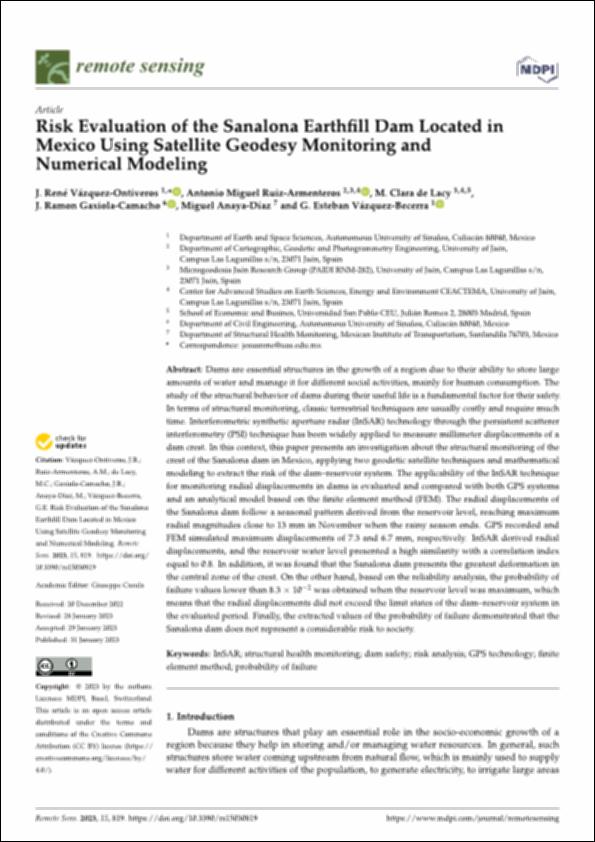Por favor, use este identificador para citar o enlazar este ítem:
http://hdl.handle.net/10637/14581Risk Evaluation of the Sanalona Earthfill Dam Located in Mexico Using Satellite Geodesy Monitoring and Numerical Modeling
| Título : | Risk Evaluation of the Sanalona Earthfill Dam Located in Mexico Using Satellite Geodesy Monitoring and Numerical Modeling |
| Autor : | Vázquez Ontiveros, J. René Ruiz-Armenteros, Antonio Miguel de Lacy Pérez de los Cobos, María Clara Gaxiola-Camacho, J. Ramón Anaya Díaz, Miguel Vázquez Becerra, G. Esteban |
| Materias: | InSAR; Structural health monitoring; Dam safety; Risk analysis; GPS technology |
| Editorial : | MDPI |
| Citación : | Vázquez-Ontiveros, J.R.; Ruiz-Armenteros, A.M.; de Lacy, M.C.; Gaxiola-Camacho, J.R.; Anaya-Díaz, M.; Vázquez-Becerra, G.E. Risk Evaluation of the Sanalona Earthfill Dam Located in Mexico Using Satellite Geodesy Monitoring and Numerical Modeling. Remote Sens. 2023, 15, 819. https://doi.org/ 10.3390/rs15030819 |
| Resumen : | Dams are essential structures in the growth of a region due to their ability to store large amounts of water and manage it for different social activities, mainly for human consumption. The study of the structural behavior of dams during their useful life is a fundamental factor for their safety. In terms of structural monitoring, classic terrestrial techniques are usually costly and require much time. Interferometric synthetic aperture radar (InSAR) technology through the persistent scatterer interferometry (PSI) technique has been widely applied to measure millimeter displacements of a dam crest. In this context, this paper presents an investigation about the structural monitoring of the crest of the Sanalona dam in Mexico, applying two geodetic satellite techniques and mathematical modeling to extract the risk of the dam–reservoir system. The applicability of the InSAR technique for monitoring radial displacements in dams is evaluated and compared with both GPS systems and an analytical model based on the finite element method (FEM). The radial displacements of the Sanalona dam follow a seasonal pattern derived from the reservoir level, reaching maximum radial magnitudes close to 13 mm in November when the rainy season ends. GPS recorded and FEM simulated maximum displacements of 7.3 and 6.7 mm, respectively. InSAR derived radial displacements, and the reservoir water level presented a high similarity with a correlation index equal to 0.8. In addition, it was found that the Sanalona dam presents the greatest deformation in the central zone of the crest. On the other hand, based on the reliability analysis, the probability of failure values lower than 8.3 102 was obtained when the reservoir level was maximum, which means that the radial displacements did not exceed the limit states of the dam–reservoir system in the evaluated period. Finally, the extracted values of the probability of failure demonstrated that the Sanalona dam does not represent a considerable risk to society. |
| URI : | http://hdl.handle.net/10637/14581 |
| Derechos: | http://creativecommons.org/licenses/by-nc-nd/4.0/deed.es OpenAccess |
| ISSN : | 2072-4292 |
| Fecha de publicación : | 31-ene-2023 |
| Centro : | Universidad San Pablo-CEU |
| Aparece en las colecciones: | Facultad de Económicas y CC Empresariales |
Los ítems de DSpace están protegidos por copyright, con todos los derechos reservados, a menos que se indique lo contrario.


